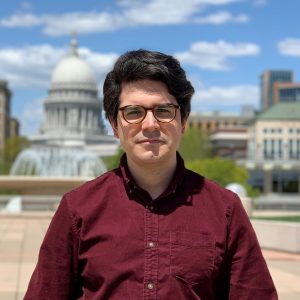
The future of transportation – think urban air mobility – calls for a new generation of manufacturing. Grad student Buzz Rankouhi is building an audacious prototype and a company to do it.
What do a Chicago skyscraper, NASA rockets and 3-D printing have in common?
For Buzz Rankouhi, something very important.
Rankouhi, a research associate at UW-Madison and CEO of Dastan Technologies, is advancing a cutting-edge project with a long legacy and deceptively simple goal.
“At the highest level, what we’re trying to do is develop a new way to combine different materials together to manufacture objects,” he says.
History provides some context.
“We can go back all the way to 1889, when we first used steel in the construction of buildings. This was a huge milestone because steel, crudely speaking, is a combination of different elements,” Rankouhi says. “We had a technology that helped us combine elements to form an alloy with enhanced properties that allowed us to build skyscrapers.”
Fast forward to the space race.
“[NASA’s Gemini project] involved figuring out a way to combine polymers, or some kind of plastic with carbon fiber. Composites would literally help us to put a man on the moon.”
Now, with support from WARF Accelerator, Rankouhi wants to leverage 3-D printing technology to open up new opportunities and a new generation of components with applications in aerospace and beyond.
Existing 3-D printing technology is capable of creating components with very complex geometries and fine features. However, crafting those fine parts out of multiple materials at the same time is currently impossible.
Buzz’s faculty advisor, Prof. Frank Pfefferkorn, sums it up:
“Today you can make a part out of copper, and another part out of stainless steel, and then figure out a way to assemble it. But being able to print that complex component in one shot, in one machine, is what we’re working on.”
It’s a formidable task. A new machine must be built, along with the know-how to run it and achieve material bonds with optimal parameters.
The multi-metal additive manufacturing system they’re envisioning allows for concurrent 3-D printing of complex parts with up to four different metals and controlled compositional gradient.
Pfefferkorn says he was attracted to the project for its “audacity.”
“The way the U.S. funding ecosystem works, we don’t often get to build machines,” he says. “We generally focus more on processes. So to be working on a first-generation prototype is exciting. That’s an opportunity that I haven’t had previously.”
They say funding from WARF Accelerator allowed them to test their design concept early, identify a flaw and “go back to the drawing board” to find a solution.
Their initial interest was manufacturing components for rocket engines. But after participating in NSF’s I-Corps program – a seven-week “bootcamp” entailing hundreds of calls with industry – Rankouhi changed course.
They are now targeting electric motors used in an emerging market called urban air mobility.
“If you want to hop from one side of town to the other in somewhere like New York or Los Angeles, we will start to see electric vehicles that take off and land vertically before the end of this decade,” Rankouhi says.
For these “air taxis,” the ability to 3-D print an electric motor in its entirely in a single process offers advantages such as weight reduction.
It also allows for a kind of design freedom not possible with conventional methods. For example, the ability to replace traditional copper windings with more efficient 3-D printed structures.
Rankouhi, who is originally from Iran, came to UW–Madison in 2016 with big dreams.
“I always wanted to start a company – that’s what got me to UW. But I didn’t have any clue how you go about doing something like that,” Rankouhi says. “Here, I decided to follow up on it more seriously and went to the business school. A lot of folks over at the business school helped me out, introduced me to all the programs and the opportunities that UW has to offer.”
“The plan is to become a company that designs and manufactures the next generation of electric machines,” he says, “using technology that WARF Accelerator is helping us develop.”